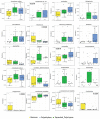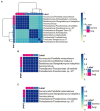The Bacterial and Fungal Gut Microbiota of the Greater Wax Moth, Galleria mellonella L. Consuming Polyethylene and Polystyrene
- PMID: 35865934
- PMCID: PMC9294514
- DOI: 10.3389/fmicb.2022.918861
The Bacterial and Fungal Gut Microbiota of the Greater Wax Moth, Galleria mellonella L. Consuming Polyethylene and Polystyrene
Abstract
Plastic production has been increasing exponentially in the last 60 years, but plastic disposal is out of control, resulting in the pollution of all ecosystems on Earth. Finding alternative environmentally sustainable choices, such as biodegradation by insects and their associated gut microbiota, is crucial, however we have only begun to characterize these ecosystems. Some bacteria and one fungus have been previously identified in the gut of Greater Wax Moth larvae (Galleria mellonella L., Lepidoptera, Pyralidae) located mainly in the Northern hemisphere. The aim of this study was to describe changes in the gut microbiota associated with the consumption of polyethylene and polystyrene by the Greater Wax Moth in Argentina, considering both bacteria and fungi. Larvae were fed polyethylene, polystyrene and beeswax as control for 7 days. Next generation sequencing revealed changes in the bacterial gut microbiome of the wax moth larvae at the phyla and genus levels, with an increase in two Pseudomonas strains. The fungal communities showed no differences in composition between diets, only changing in relative abundance. This is the first report of both bacterial and fungal communities associated with a plastivore insect. The results are promising and call for more studies concerning a potential multi-kingdom synergy in the plastic biodegradation process.
Keywords: Argentina; bacteria; fungi; insect gut; plastic pollution; plastivore.
Copyright © 2022 Ruiz Barrionuevo, Vilanova-Cuevas, Alvarez, Martín, Malizia, Galindo-Cardona, de Cristóbal, Occhionero, Chalup, Monmany-Garzia and Godoy-Vitorino.
Conflict of interest statement
The authors declare that the research was conducted in the absence of any commercial or financial relationships that could be construed as a potential conflict of interest.
Figures






Similar articles
-
Degradation of agricultural polyethylene film by greater wax moth (Galleria mellonella) larvae and screening of involved gut bacteria.Ecotoxicol Environ Saf. 2025 Aug 18;303:118841. doi: 10.1016/j.ecoenv.2025.118841. Online ahead of print. Ecotoxicol Environ Saf. 2025. PMID: 40829281
-
Co-diet supplementation of low density polyethylene and honeybee wax did not influence the core gut bacteria and associated enzymes of Galleria mellonella larvae (Lepidoptera: Pyralidae).Int Microbiol. 2023 May;26(2):397-409. doi: 10.1007/s10123-022-00303-3. Epub 2022 Dec 9. Int Microbiol. 2023. PMID: 36484909
-
Consumption of low-density polyethylene, polypropylene, and polystyrene materials by larvae of the greater wax moth, Galleria mellonella L. (Lepidoptera, Pyralidae), impacts on their ontogeny.Environ Sci Pollut Res Int. 2022 Sep;29(45):68132-68142. doi: 10.1007/s11356-022-20534-1. Epub 2022 May 9. Environ Sci Pollut Res Int. 2022. PMID: 35532825
-
The Biology and Control of the Greater Wax Moth, Galleria mellonella.Insects. 2017 Jun 9;8(2):61. doi: 10.3390/insects8020061. Insects. 2017. PMID: 28598383 Free PMC article. Review.
-
Using Insect Larvae and Their Microbiota for Plastic Degradation.Insects. 2025 Feb 5;16(2):165. doi: 10.3390/insects16020165. Insects. 2025. PMID: 40003794 Free PMC article. Review.
Cited by
-
Upcycling Polystyrene.Polymers (Basel). 2022 Nov 18;14(22):5010. doi: 10.3390/polym14225010. Polymers (Basel). 2022. PMID: 36433142 Free PMC article. Review.
-
A Falciformispora senegalensis grain model in Galleria mellonella larvae.Med Mycol. 2023 Aug 2;61(8):myad070. doi: 10.1093/mmy/myad070. Med Mycol. 2023. PMID: 37451815 Free PMC article.
-
Comparative gut microbiome research through the lens of ecology: theoretical considerations and best practices.Biol Rev Camb Philos Soc. 2025 Apr;100(2):748-763. doi: 10.1111/brv.13161. Epub 2024 Nov 12. Biol Rev Camb Philos Soc. 2025. PMID: 39530277 Free PMC article. Review.
-
Gut microbiota variation of a tropical oil-collecting bee species far exceeds that of the honeybee.Front Microbiol. 2023 May 17;14:1122489. doi: 10.3389/fmicb.2023.1122489. eCollection 2023. Front Microbiol. 2023. PMID: 37266018 Free PMC article.
-
The Future Exploring of Gut Microbiome-Immunity Interactions: From In Vivo/Vitro Models to In Silico Innovations.Microorganisms. 2024 Sep 4;12(9):1828. doi: 10.3390/microorganisms12091828. Microorganisms. 2024. PMID: 39338502 Free PMC article. Review.
References
-
- Anderson M. J. (2001). Permutation tests for univariate or multivariate analysis of variance and regression. Can. J. Fish. Aquat. Sci. 58, 626–639. doi: 10.1139/f01-004 - DOI
-
- Bray J. R., Curtis J. T. (1957). An ordination of the upland forest communities of southern Wisconsin. Ecol. Monogr. 27, 325–349. doi: 10.2307/1942268 - DOI
Grants and funding
LinkOut - more resources
Full Text Sources
Miscellaneous

